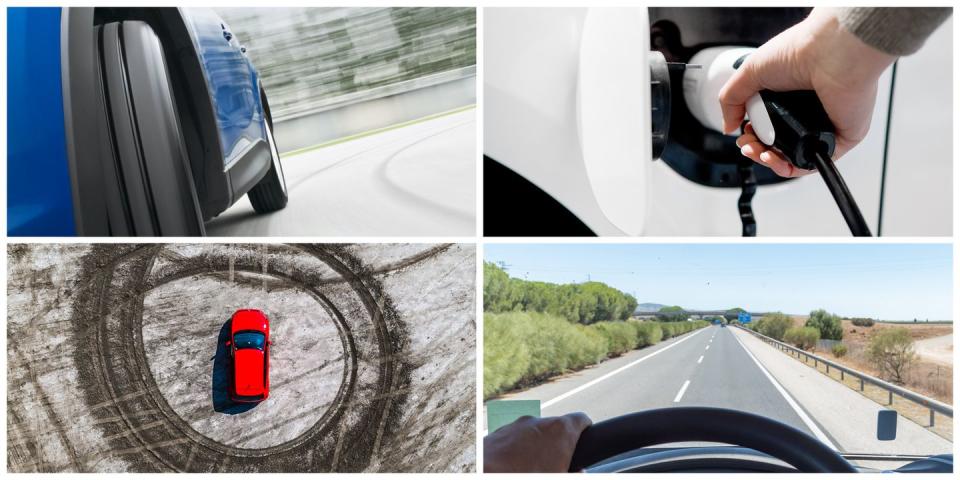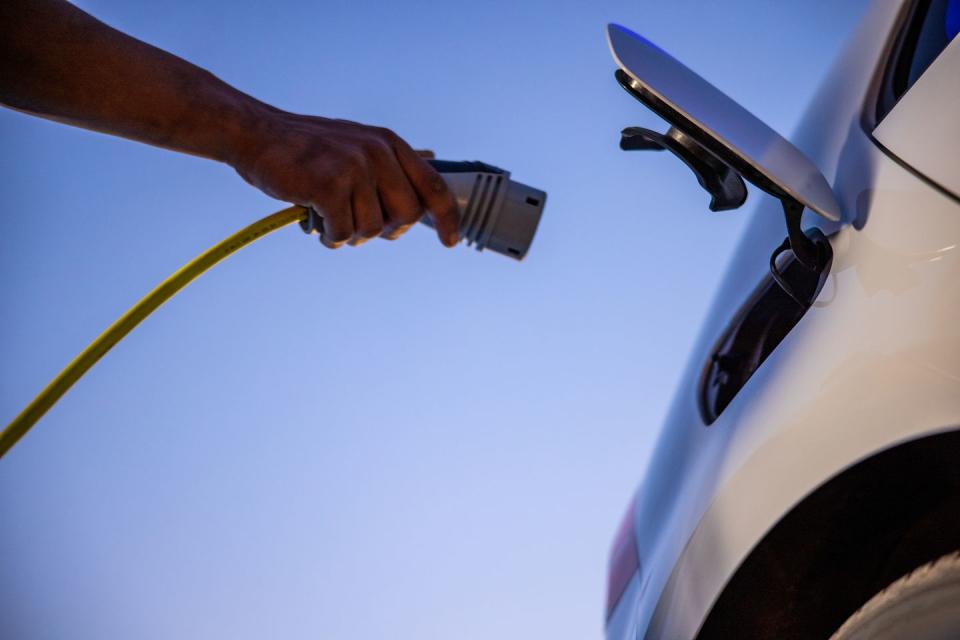Why We Test EVs the Way We Do

Testing is a core tenet at Car and Driver, something that's been infused into everything we do since 1956. This foundation of objective data combined with our subjective observations brings serious depth to our reviews. It allows us to move from statements like "this car feels quicker to 60 mph" to definitive conclusions about speed, cornering grip, interior noise, cargo volume, and a host of other important vehicle attributes. But the relatively recent influx of electric vehicles has caused us to alter our usual testing regimen in a few ways, and we've also added a couple of EV-specific tests for range and charging.
Most Tests Still the Same, Some Altered
Whether a car is powered solely by electrons or not doesn't affect many of our tests, which include things like stuffing carry-on-suitcase-size boxes into the back of cargo areas, measuring how much a vehicle's pillars block outward visibility, or seating height. And the fact that we weigh every car we test allows us to track precisely how much heavier EVs are than comparable gasoline-powered vehicles.
We always top off the gas tank before weighing a vehicle. But that's not necessary with EVs, since a fully charged battery pack doesn't weigh any more. For our performance testing—acceleration, braking, skidpad, top speed—we do modify the order in which we run the tests for EVs. Because the maximum power output of a battery pack decreases as the state of charge dwindles, we always do our standing-start-acceleration runs first with the battery as close to 100 percent as possible. We typically plug the test vehicles in at the array of chargers at the test track and charge them fully, which leaves us about a mile to get to the straightaway. Another juicing option we've used from time to time is to charge a vehicle fully at our office and then haul it out to the test track on a trailer.
75-MPH Highway Range Test
Range is the all-important number for buyers of EVs, far more important than the vehicles' efficiency figures (MPGe). Every vehicle has a range number displayed on its window sticker, which is arrived at according to the EPA's methodology. But we wanted to come up with our own real-world range figure for two big reasons: first, there's some wiggle room in the EPA's rules, and automakers are allowed to use different methods to arrive at that range figure. That means EPA range figures don't necessarily provide an exact comparison between any two vehicles. Also, the EPA test cycles run at considerably slower speeds than drivers typically experience on our interstates. We chose 75 mph for our test because driving at a steady elevated speed is the worst range case for an EV (this is not the case for a gas-powered car, which we run at 75 mph to get a highway fuel-economy figure). Another reason is that range matters most in a scenario like a highway road trip where you're driving a lot of miles in a day; nearly every EV on the market has sufficient range when stuck in slow city traffic for hours upon hours.
We run our range tests primarily on the highways surrounding our Ann Arbor, Michigan, office, and we typically run them during the middle of the day, or on nights or weekends, when the traffic is lightest. We start with a full charge and run at a GPS-verified 75 mph for as long as possible, turning around at the halfway point to end back in our office parking lot. We record the entire run with a VBox LapTimer or Driftbox and also record the battery state of charge and the vehicle's predicted range every five miles. We compile those data points into two trend lines that we use to extrapolate the last few percent of battery that we didn't use. We've been generally surprised at just how linear the decline in the battery's charge is, and that there aren't big drop-offs along the way to zero. We then round down the range to the nearest 10-mile increment.

Some EVs get as much as 20 percent less range than the window sticker figure in our highway test, although others, typically from German automakers, have exceeded their EPA range figures. This validates our reasoning for doing our own testing, both because of highway range falling well short of the window-sticker number and because those figures aren't a perfect apples-to-apples comparison.
DC Fast-Charging Test
The other EV-specific test that we do is a fast-charging test, where we charge each vehicle from a 10 to 90 percent state of charge on the fastest charging equipment a vehicle can handle. Why not all the way from empty to 100 percent? First, it's logistically challenging, but it's also not how EV owners use fast-charging. Because the rate of charge slows considerably at the battery nears full, it's a waste of time to sit and wait for it to charge all the way. For example, it might take the same amount of time to charge from 10 to 80 percent as it does from 80 to 90 percent. When road tripping with an EV, it's more time-efficient to stop more often for shorter periods.
For our charging test, we record the rate of charging and the battery's state of charge every minute as well as how many minutes (or hours and minutes) it takes to complete the test. The most interesting and comparable detail is the average charge rate over the entire test, but it's also a technological bragging point to have the highest peak. In addition, the amount of energy put into the vehicle versus how much the battery pack contains allows us to calculate the losses that happen during fast charging.
Learning the ins and outs of EVs continues to be extremely interesting, and no matter how the auto industry evolves, we'll be looking for ways to test whatever vehicles are hitting our roads.
You Might Also Like

 Yahoo Autos
Yahoo Autos 